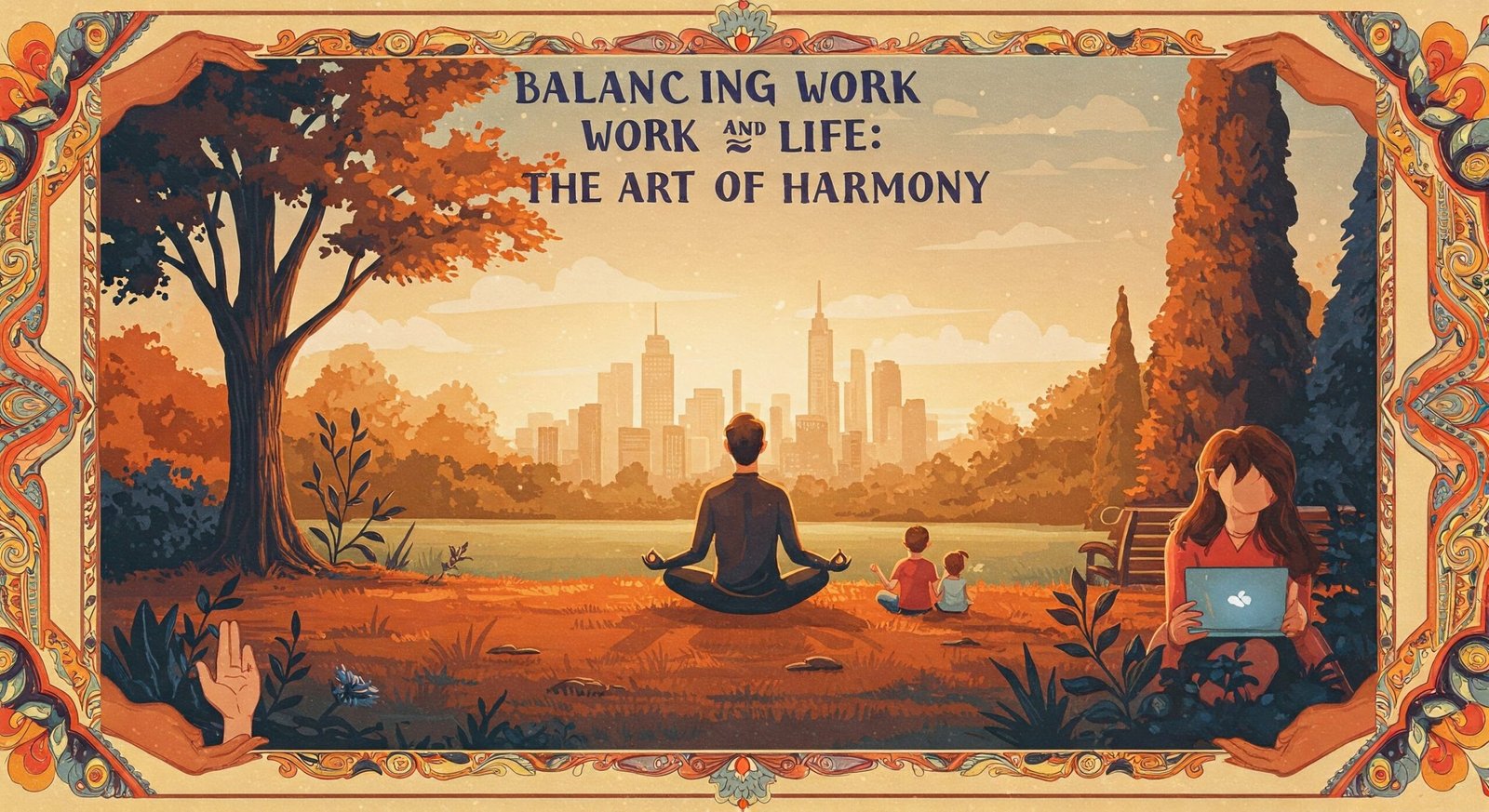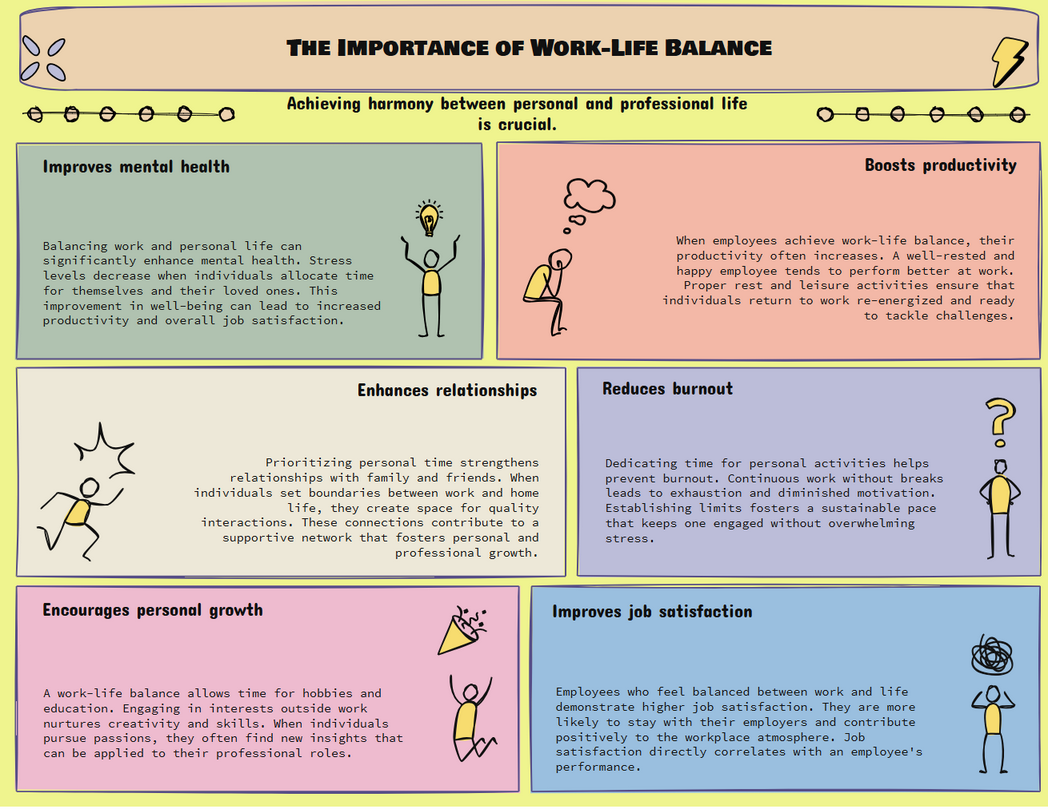
Balancing Work and Life: In today’s fast-paced world, achieving a balance between work and personal life can be challenging. With increasing work demands, digital distractions, and personal responsibilities, many professionals struggle to find a sense of harmony. Work-life balance is essential for maintaining mental and physical well-being, enhancing productivity, and fostering strong relationships. Without balance, stress and burnout become inevitable, affecting overall well-being and career performance. Achieving work-life harmony is about integrating both areas to promote fulfillment and sustainability.
The Importance of Work-Life Balance

Maintaining a healthy work-life balance reduces stress, boosts job satisfaction, strengthens relationships, and leads to higher productivity. Companies that support work-life balance benefit from lower turnover, higher morale, and improved performance.
On a personal level, achieving a work-life balance helps professionals nurture relationships with family and friends, pursue their hobbies, and prioritize their health. A well-balanced life contributes to long-term happiness and personal growth, ensuring that work remains fulfilling rather than overwhelming.
Common Challenges in Balancing Work and Life
Balancing Work and Life Many factors contribute to work-life imbalance. Some common challenges include:
- Long Work Hours: Excessive work hours reduce personal time, leading to fatigue and stress.
- Remote Work and Digital Connectivity: The rise of remote work and constant digital connectivity blurs the boundaries between work and personal life.
- High Workplace Expectations: Pressure to perform, meet deadlines, and stay competitive can result in overworking.
- Personal Responsibilities: Family obligations, household chores, and caregiving responsibilities add to the challenge of managing time effectively.
- Lack of Time Management Skills: Poor planning and ineffective time management contribute to feelings of being overwhelmed.
Strategies to improve work life balance

Implementing structured time management techniques, such as the Pomodoro Technique or time-blocking, can enhance work-life balance by allocating specific periods for focused work and personal activities, reducing burnout and improving productivity.
Finding the right balance requires intentional effort and smart strategies. Here are some effective ways to achieve work-life harmony:
1. Set Clear Boundaries Between Work and Personal Life
One of the most effective ways to maintain balance is by establishing clear boundaries. Set specific work hours and stick to them. Avoid checking emails or responding to work messages outside of designated work times. Communicate these boundaries to colleagues and family members to ensure mutual respect.
2. Prioritize Tasks and Manage Time Effectively
In Balancing Work and Life, Effective time management helps professionals handle workloads efficiently while making time for personal activities. Use tools like to-do lists, calendar apps, and productivity techniques such as the Pomodoro Technique to stay focused. Prioritize tasks based on urgency and importance to avoid unnecessary stress.
3. Learn to Say No and Delegate Tasks
Many professionals take on excessive work due to the fear of disappointing others. Learning to say no to additional tasks and delegating responsibilities when possible can prevent burnout. Recognizing personal limits is essential for maintaining balance and productivity.
4. Take Regular Breaks and Unplug
Taking short breaks throughout the workday improves focus and reduces stress. Step away from screens, stretch, and engage in activities that help recharge your energy. Additionally, unplugging from work-related technology after hours fosters relaxation and mindfulness.
5. Adopt a Flexible Work Approach
Many companies now offer flexible work arrangements, such as remote work, compressed workweeks, and adjustable schedules. In Balancing Work and Life, consider exploring flexible work options that align with both personal and professional needs, if possible. Flexibility enables professionals to manage responsibilities more effectively without compromising performance.
6. Make Time for Personal Interests and Self-Care
Engaging in hobbies, exercise, and relaxation activities is crucial for maintaining both mental and physical well-being. Set aside time for activities that bring joy, whether it’s reading, painting, exercising, or spending time with loved ones. Practicing mindfulness, meditation, or yoga can further enhance emotional resilience.
7. Maintain Healthy Relationships
Balancing Work and life fosters strong personal relationships, contributing to emotional support and overall happiness. Spend quality time with family and friends, engage in meaningful conversations, and avoid letting work interfere with personal commitments. Having a strong support system provides encouragement and balance.
8. Avoid Perfectionism and Unrealistic Expectations
Striving for perfection in both work and personal life can lead to stress and dissatisfaction. Set realistic expectations and accept that not everything will always go as planned. Focus on progress rather than perfection and celebrate small achievements along the way.
9. Seek Professional Help if Needed
If work-life balance feels overwhelming, seeking guidance from a mentor, coach, or therapist can be beneficial. Professional support helps individuals gain clarity, develop effective coping strategies, and create a sustainable plan for achieving a balanced life.
10. Foster a Positive Work Environment
Workplaces that support work-life balance contribute to employee well-being and satisfaction. Employers can implement policies that promote flexible work arrangements,Balancing Work and Life mental health programs, and stress management initiatives. Encouraging open communication and recognizing employees’ efforts helps create a healthy work culture.
The Role of Employers in Promoting Work-Life Balance
Companies play a vital role in fostering a balanced work environment. Organizations that prioritize employee well-being experience higher retention rates, increased engagement, and improved productivity. Some ways employers can promote work-life balance include in Balancing Work and Life:
- Encouraging flexible work arrangements
- Providing wellness programs and mental health resources
- Setting realistic workload expectations
- Recognizing and rewarding employees for their contributions
- Promoting a culture of respect and support
Achieving Long-Term Work-Life Harmony
Work-life balance is not a one-time achievement, but an ongoing process that evolves with changes in career and life. Regularly assessing priorities, making adjustments, and staying committed to well-being ensures long-term harmony. Balancing Work and Life. Professionals who successfully balance work and personal life experience higher job satisfaction, better health, and greater overall happiness.
Conclusion
Balancing work and life is crucial for achieving long-term success and maintaining overall well-being. By setting boundaries, managing time effectively, prioritizing self-care, and fostering strong relationships, professionals can achieve a fulfilling and sustainable lifestyle. Both individuals and employers have a role in creating a culture that values work-life balance. Taking intentional steps towards harmony in a busy world leads to improved productivity, happiness, and overall success.



Pingback: Continuous Learning: Staying Relevant in Your Industry - Pivot Yourself
Pingback: The Psychology of Consumer Behavior: What Drives Buying Decisions? - Pivot Yourself
Pingback: Networking Strategies: Expanding Your Professional Connections - Pivot Yourself
Pingback: Unlocking the Secrets of Job Satisfaction: A Comprehensive Guide - Pivot Yourself